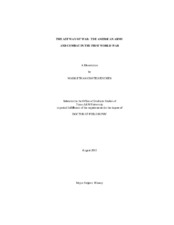| dc.description.abstract | Many scholars of the First World War have examined the European armies in new ways that have shown not only how those armies actually fought along the Western Front, but how they changed their ideas and methods over time, and why they fought the way they did. This dissertation does the same for the American Expeditionary Forces (AEF). It examines how four AEF divisions (the 1st, 2nd, 26th, and 77th) planned and conducted their battles, what they learned about modern combat in those battles, and how they adapted their doctrine, tactics, and other operational methods during the war. Although this dissertation describes AEF training and operations, its focus is on ideas and methods, and the changes in both during the war. It shows that when the United States joined the war in 1917, the U.S. Army was doctrinally unprepared for the industrial combat of the Western Front. It demonstrates that General John J. Pershing and other AEF leaders accepted this inadequate prewar doctrine, with only minor modification, as the official doctrine of the AEF. Many early American attacks suffered from these unrealistic ideas, which retained too much faith in the infantry rifleman on a battlefield dominated by artillery, machine guns, and barbed wire. However, this dissertation also shows that AEF divisions adjusted their doctrine, tactics, and other operational methods, as they fought. Experienced divisions prepared more comprehensive attack plans, employed more flexible infantry formations, and maximized firepower to seize limited objectives. Although some of these adaptations were accepted by senior officers at AEF General Headquarters (GHQ), the American First Army, and the various corps, the lessons seem to have been learned first, and best, by officers and men within the combat divisions. Often the extent of these changes reduced the operational relevance of senior officers at GHQ, including Pershing, many of whom failed to make the same doctrinal adjustments. In short, this study exposes the battle of ideas waged within the AEF, between those who adhered to the traditional, human-centered ideas of the prewar army and those who increasingly appreciated the modern, industrial ideas then prevalent in the European armies. | en |


